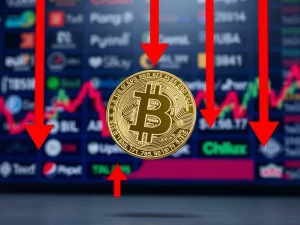Ethereum Price Struggle: Unsettling Data Casts Doubt on ETH Recovery Beyond $4K

The cryptocurrency market often experiences volatility. Currently, the **Ethereum price** faces significant challenges. It struggles to maintain its position above the critical $4,000 threshold. This ongoing battle leaves many investors questioning the prospects for a robust **ETH recovery**. Recent market data indeed leans bearish, suggesting potential headwinds for the second-largest cryptocurrency.
The Elusive $4,000 Mark for Ethereum Price
Ethereum (ETH) has consistently oscillated around the $4,000 level for several weeks. This period of consolidation followed a sharp drop below $3,500 earlier in the month. Traders are carefully assessing the market’s direction. They seek clear signals for sustained bullish momentum. The United States Federal Reserve’s recent announcement of a 0.25% interest rate cut and the conclusion of quantitative tightening did not provide the expected boost. Instead, the **Ethereum price** continues to waver, reflecting underlying market uncertainty.
Holding above $4,000 is crucial for Ethereum’s psychological and technical strength. Failure to do so often signals a lack of buyer conviction. This level acts as a key battleground between bulls and bears. A decisive break above it could ignite further upward movement. Conversely, a sustained drop below it might trigger more selling pressure. Therefore, observing ETH’s interaction with this price point offers vital insights into its short-term trajectory. Many analysts believe this resistance needs to fall for any meaningful **ETH recovery**.
Weak Futures Demand Signals Bearish Sentiment
Market indicators provide further insights into current trends. Ethereum futures contracts currently trade at a modest 5% premium. This figure is relative to standard ETH spot markets. Typically, in neutral market conditions, futures premiums range between 5% and 10%. This range accounts for the longer settlement periods associated with futures. A lower premium, like the current 5%, suggests diminished demand from buyers. These buyers typically use leverage to amplify their positions. This weak demand underscores a prevailing **bearish sentiment** among leveraged traders.
Moreover, even a recent brief recovery to $4,250 failed to restore sustained bullish sentiment. This indicates a deeper lack of conviction in the market. Traders remain cautious. They are unwilling to commit significant capital to long positions. This trend in futures markets often foreshadows broader price movements. Consequently, the subdued futures activity highlights a critical hurdle for any potential **ETH recovery**. The lack of aggressive buying interest through derivatives suggests that many investors are not anticipating immediate significant gains.
Ethereum ETFs Face Outflows and Diminished Momentum
The performance of US-based **Ethereum ETFs** also paints a concerning picture. These exchange-traded funds have experienced consistent net outflows since mid-October. This trend suggests institutional investors are either reducing their exposure or are not actively accumulating ETH. Even a notable $380 million in net inflows recorded on a recent Monday and Tuesday did little to generate bullish momentum. This outcome left many traders questioning previous optimistic price targets.
The failure of these substantial inflows to ignite a rally is particularly telling. It indicates that the selling pressure or general market caution outweighs new capital entering the market. For many, the $10,000 ETH price target, once widely discussed for this cycle, now appears increasingly unrealistic. The performance of **Ethereum ETFs** serves as a significant barometer for institutional interest. Their current struggles underscore the broader **bearish sentiment** impacting Ethereum’s market. This situation highlights the need for sustained, positive institutional flows to support a robust **ETH recovery**.
Declining On-Chain Activity and Network Fees
Another crucial factor impacting Ethereum’s inability to hold $4,000 is the decline in network activity. This issue affects the entire cryptocurrency market to some extent. Ethereum chain fees totaled approximately $5 million over the past seven days. This represents a 16% decrease from the preceding week. Declining network fees are a direct indicator of lower on-chain demand. Fewer transactions and less network congestion naturally lead to reduced fees. This trend suggests that users are interacting less with the Ethereum blockchain.
For comparison, fees on BNB Chain dropped by 30% during the same period. Tron experienced a 16% decline. However, the number of active addresses on Ethereum’s base layer also dropped by 4%. In contrast, Tron saw an impressive increase of over 100% in active addresses. This specific piece of **crypto market data** reveals a relative decline in Ethereum’s direct user engagement. Lower active addresses and fees often correlate with reduced utility and speculative interest. This situation further complicates the path for a strong **ETH recovery**.
Analyzing the Technical Landscape: Bear Trap or Deeper Decline?
Technical analysis offers further clues about Ethereum’s immediate future. Data from Crypto News Insights Markets Pro and TradingView shows that the **Ethereum price** has printed a third consecutive red candlestick on the daily chart. Several attempts to recover have been decisively rejected at the $4,000 resistance level. This pattern prompts traders to debate whether Ethereum’s upside potential is exhausted or if it is merely undergoing a technical correction. Analysts are divided on this crucial point.
Ted Pillows, a prominent analyst, commented on X (formerly Twitter) that “$ETH has lost its $4,000 support level again.” He highlighted that despite positive macroeconomic news, such as the Fed’s rate cut and the end of quantitative tightening, Ethereum remained down. Pillows’ accompanying chart indicated that the next line of defense for ETH was $3,800. Losing this level, he warned, could trigger another sell-off. This could push the price first toward the $3,500-$3,700 demand zone, and potentially further down to the $3,354 low seen on August 3. Such a move would certainly deepen the existing **bearish sentiment**.
Conversely, reclaiming the $4,000 mark would significantly bolster the bulls. This action would shift their focus toward overcoming barriers at $4,200 and $4,500. Success here could pave the way for a return to all-time highs above $5,000. Pillows concluded his analysis with a stark question: “Either this is a classic bear trap, or the crypto market is going way lower.” This statement perfectly encapsulates the current uncertainty surrounding the **ETH recovery**.
Expert Insights on ETH Recovery Prospects
Other analysts offer varying perspectives on the current market situation. Fellow analyst FibonacciTrading suggested that a “dip toward $3,300 would still count as a healthy pullback within the uptrend.” This view is supported by the EMA cloud visible on the weekly chart. FibonacciTrading emphasized the importance of defending current support levels. He noted, “It will be a real show of strength if the bulls can defend support here and set up for the next attack on resistance.” This perspective views the current downturn as a natural part of a larger upward trend, provided key supports hold. This is a crucial piece of **crypto market data** for long-term holders.
Pseudonymous analyst Cactus maintains a more optimistic outlook for the long term. He believes Ether’s upside remains on track. A “strong Q4 is still on the cards,” he asserts, as long as bulls can defend the $3,800-$4,200 support region. As Crypto News Insights previously reported, bulls must push the **Ethereum price** above the 50-day Simple Moving Average (SMA) at $4,200. This move would signal renewed strength and confirm the beginning of the next upward leg. These expert opinions highlight the diverse interpretations of current market conditions and the potential paths for **ETH recovery**.
Macroeconomic Factors Influencing Ethereum Price
Macroeconomic factors play a significant role in cryptocurrency market movements. The US Federal Reserve’s decision to cut interest rates by 0.25% and end quantitative tightening (QT) was largely anticipated. Historically, such dovish monetary policies tend to be bullish for risk assets like cryptocurrencies. However, in this instance, the announcements did not trigger the expected rally for the **Ethereum price**. This suggests that other factors are currently weighing more heavily on investor sentiment. The market may have already priced in these events, or broader economic concerns persist.
Global economic conditions, including inflation concerns and geopolitical tensions, can influence investor appetite for risk. When uncertainty is high, investors often move away from volatile assets. This shift can contribute to a prevailing **bearish sentiment**. Therefore, while the Fed’s actions are important, they are only one piece of a complex puzzle. Understanding the interplay of these macro factors with specific **crypto market data** is essential for forecasting Ethereum’s future trajectory. A true **ETH recovery** often requires a confluence of positive technical and fundamental signals, alongside a supportive macroeconomic environment.
The Road Ahead: Reclaiming Key Resistance for ETH Recovery
For Ethereum to resume a significant upward trend, it must overcome several critical resistance levels. The immediate challenge remains reclaiming and holding the $4,000 mark. A successful breach of this psychological and technical barrier would instill confidence among buyers. Following this, the bulls would target $4,200, which aligns with the 50-day SMA. This moving average is a widely watched indicator of short-to-medium term trend strength. Breaking above it would be a strong bullish signal.
Further upward momentum would then focus on the $4,500 resistance. Sustained trading above these levels is crucial. It would confirm a shift in market dynamics and invalidate the current **bearish sentiment**. Ultimately, a return to all-time highs above $5,000 would require overcoming these hurdles systematically. The path for a full **ETH recovery** is clearly defined by these technical checkpoints. Each successful reclaim of a resistance level builds the foundation for the next stage of growth. Investors will closely watch these levels for signs of strength.
Comparing Ethereum’s Performance to Other Altcoins
While Ethereum faces its own set of challenges, it is also important to consider its performance relative to other altcoins. The decline in network fees, for example, affected BNB Chain and Tron as well. BNB Chain saw a 30% drop in fees, and Tron experienced a 16% decline. This indicates a broader market trend of reduced on-chain activity. However, Ethereum’s 4% drop in active addresses contrasts sharply with Tron’s over 100% increase. This specific piece of **crypto market data** highlights a unique challenge for Ethereum.
Tron’s surge in active addresses suggests it might be capturing a segment of the market that Ethereum is currently missing. This could be due to lower transaction costs or specific use cases gaining traction. Therefore, while some issues are market-wide, Ethereum’s relative underperformance in user engagement is a concern. A robust **ETH recovery** might require not only internal strength but also competitive performance against other layer-1 blockchains. Understanding these comparisons helps investors gauge Ethereum’s standing within the broader altcoin ecosystem.
Navigating Market Volatility: Strategies Amidst Bearish Sentiment
In periods of heightened market volatility and **bearish sentiment**, investors must adopt prudent strategies. Conducting thorough research is paramount. Do not rely solely on short-term price movements. Understanding the fundamentals of Ethereum, including its technological developments and ecosystem growth, remains vital. Diversification across different assets can also mitigate risk. However, this article does not offer investment advice. Every investment and trading decision carries inherent risks. Readers must perform their own due diligence.
Long-term investors often view pullbacks as opportunities for accumulation. Short-term traders, conversely, might focus on identifying key support and resistance levels for entry and exit points. Monitoring key **crypto market data** indicators, such as futures premiums, ETF flows, and on-chain metrics, provides valuable insights. Staying informed about macroeconomic trends also helps in making informed decisions. Ultimately, patience and a clear understanding of personal risk tolerance are crucial for navigating periods of uncertainty. The path for a complete **ETH recovery** may be winding, requiring careful consideration from all market participants.
Conclusion: The Uncertain Path for ETH Recovery
Ethereum currently finds itself at a critical juncture. The **Ethereum price** struggles to maintain its footing above $4,000. Weak futures demand, persistent outflows from **Ethereum ETFs**, and declining on-chain activity all contribute to a prevailing **bearish sentiment**. While some analysts suggest the current downturn could be a healthy correction or a ‘bear trap,’ the immediate outlook remains cautious. Reclaiming key resistance levels, particularly $4,000 and the 50-day SMA at $4,200, is essential for any significant **ETH recovery**.
The confluence of technical and fundamental indicators points to a market grappling with uncertainty. Investors must carefully monitor incoming **crypto market data** and expert analyses. The journey back to previous highs, or even a sustained hold above $4,000, will likely require a renewed surge in demand. It also needs a clear shift in market sentiment. Until then, Ethereum’s path forward appears fraught with challenges, demanding vigilance from all market participants. The question of whether Ethereum can truly recover remains open, dependent on these crucial market dynamics.










